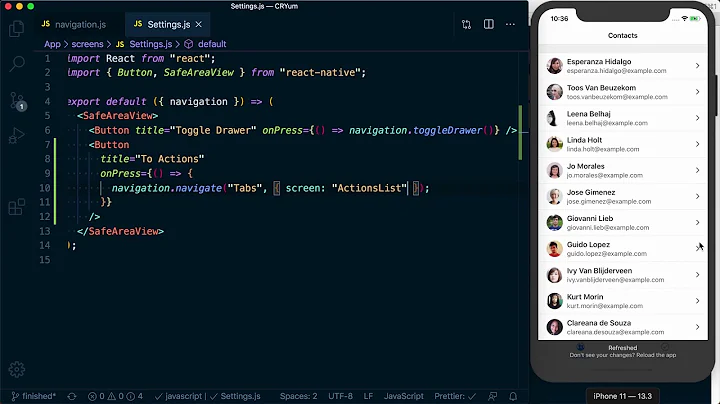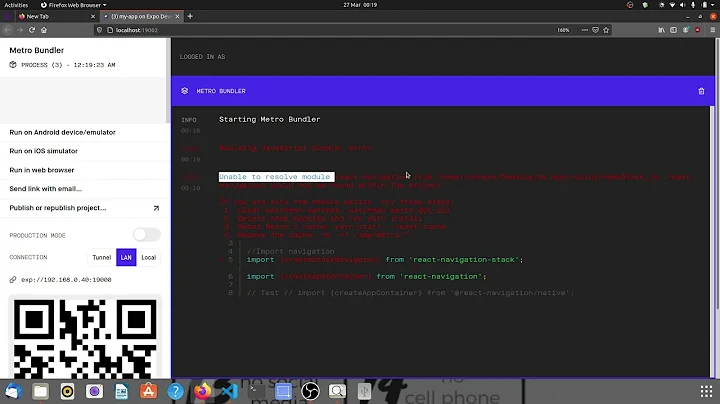React Native - navigation issue "undefined is not an object (this.props.navigation.navigate)"
Solution 1
With Expo you should't do the App registration your self instead you should let Expo do it, keeping in mind that you have to export default component always: Also you need to import View and Button from react-native: please find below the full code:
import React from 'react';
import {
AppRegistry,
Text,
View,
Button
} from 'react-native';
import { StackNavigator } from 'react-navigation';
class HomeScreen extends React.Component {
static navigationOptions = {
title: 'Welcome',
};
render() {
const { navigate } = this.props.navigation;
return (
<View>
<Text>Hello, Chat App!</Text>
<Button
onPress={() => navigate('Chat', { user: 'Lucy' })}
title="Chat with Lucy"
/>
</View>
);
}
}
class ChatScreen extends React.Component {
// Nav options can be defined as a function of the screen's props:
static navigationOptions = ({ navigation }) => ({
title: `Chat with ${navigation.state.params.user}`,
});
render() {
// The screen's current route is passed in to `props.navigation.state`:
const { params } = this.props.navigation.state;
return (
<View>
<Text>Chat with {params.user}</Text>
</View>
);
}
}
const SimpleAppNavigator = StackNavigator({
Home: { screen: HomeScreen },
Chat: { screen: ChatScreen }
});
const AppNavigation = () => (
<SimpleAppNavigator />
);
export default class App extends React.Component {
render() {
return (
<AppNavigation/>
);
}
}
Solution 2
Additional Info:
When you are nesting child components, you need to pass navigation as prop in parent component.
//parent.js
<childcomponent navigation={this.props.navigation}/>
And you can access navigation like this
//child.js

this.props.navigation.navigate('yourcomponent');
Reference: https://reactnavigation.org/docs/en/connecting-navigation-prop.html
Solution 3
As Bobur has said in his answer, the navigation prop isn't passed to children of the routed component. To give your components access to navigation you can pass it as a prop to them, BUT there is a better way.
If you don't want to pass the navigation prop all the way down your component hierarchy, you can use useNavigation instead. (Which in my opinion is just cleaner anyways, and reduces the amount of code we have to write):
function MyBackButton() {
const navigation = useNavigation();
return (
<Button
title="Back"
onPress={() => {
navigation.goBack();
}}
/>
);
}
https://reactnavigation.org/docs/use-navigation/
This is just really nice because if you have multiple levels of components you wont have to continuously pass the navigation object as props just to use it. Passing navigation just once requires us to 1. Add a prop to the component we want to pass it to. 2. Pass the prop from the parent component. 3. Use the navigation prop to navigate. Sometimes we have to repeat steps 1 and 2 to pass the prop all the way down to the component that needs to use navigation. We can condense steps 1 and 2, no matter how many times they are repeated, into a single useNavigation call with this method.
I think it is best.
Related videos on Youtube
user3676224
Updated on July 09, 2022Comments
-
user3676224 almost 2 years
Im following this tutorial https://reactnavigation.org/docs/intro/ and im running into a bit of issues.
Im using the Expo Client app to render my app every time and not a simulator/emulator.
my code is seen down below.
I originally had the "SimpleApp" const defined above "ChatScreen" component but that gave me the following error:
Route 'Chat' should declare a screen. For example: ...etc
so I moved the decleration of SimpleApp to just above "AppRegistry" and that flagged a new error
Element type is invalid: expected string.....You likely forgot to export your component..etc
the tutorial did not add the key words "export default" to any component which I think it may have to do with the fact that im running it on the Expo app? so I added "export default" to "HomeScreen" and the error went away.
The new error that I cant seem to get rid off(based on the code below) is the following:
undefined is not an object (evaluating 'this.props.navigation.navigate')
I can't get rid of it unless I remove the "{}" around "const {navigate}" but that will break the navigation when I press on the button from the home screen
import React from 'react'; import {AppRegistry,Text,Button} from 'react-native'; import { StackNavigator } from 'react-navigation'; export default class HomeScreen extends React.Component { static navigationOptions = { title: 'Welcome', }; render() { const { navigate } = this.props.navigation; return ( <View> <Text>Hello, Chat App!</Text> <Button onPress={() => navigate('Chat')} title="Chat with Lucy" /> </View> ); } } class ChatScreen extends React.Component { static navigationOptions = { title: 'Chat with Lucy', }; render() { return ( <View> <Text>Chat with Lucy</Text> </View> ); } } const SimpleApp = StackNavigator({ Home: { screen: HomeScreen }, Chat: { screen: ChatScreen }, }); AppRegistry.registerComponent('SimpleApp', () => SimpleApp);-
Milan Gulyas almost 7 yearsSeems like this.props.navigation is undefined when first rendered. You can try removing the line
const { navigate } = this.props.navigation;and usingonPress={() => this.props.navigation.navigate('Chat')}so it will access the object only later. -
user3676224 almost 7 yearsI tried that, I got prompted to press on the button, but when i did i ran in to this error, "undefined is not an object (evaluating '_this2.props.navigation.navigate')" And I do have react-navigation npm module installed
-
Milan Gulyas almost 7 yearsFor me the navigation works fine, just needed to import View from react-native, but I am not running it in Expo.
-
Andrew Koster over 4 yearsIf I was designing a navigation API to be as obtuse and fragile as possible, I could not do worse than React navigation.
-
-
user3676224 almost 7 yearsThank you so much! it worked! Can you elaborate more on the part where i shouldn't do appregistration myself with expo ? And just to confirm, I always need to export a default component WHICH will be rendered initially ? Also, Any reason you made AppNavigation and instance of SimpleAppNavigator ? is this best practice?
-
Ahmed Khaled Mohamed almost 7 yearsso normally if you are testing without Expo you would register your app with for example:
AppRegistry.registerComponent('SimpleApp', () => SimpleApp);But with Expo it will take the root Component exported as default and it will show it in the Expo app: 'export default class App extends React.Component { render() { return ( <AppNavigation/> ); } }' don't forget to mark the answer as the correct answer. -
user3676224 almost 7 yearsdone! could you also explain why you placed the simpleAppNavigator into AppNavigation and then rendered into a different component ? is that best practice?
-
Ahmed Khaled Mohamed almost 7 yearsHere it might look not important.. but in general you wanna have this separation.. because your navigator could be in another file only concerned with this part of the routing.. but your navigation could have extended logic like for example binding with the store with redux.. and also navigation could include a combination of a tab navigator and several stack navigators for example.
-
 Ricky Dam almost 7 years@AhmedKhaledA.Mohamed You are a god. The docs here reactnavigation.org/docs/intro are super outdated and the example is broken right out the box. You should be the one writing the example for them haha. Spent several hours on this error. Everyone on the internet is asking this question and are super confused and running in circles. Thanks man!! (bounty for you in 23 hours)
Ricky Dam almost 7 years@AhmedKhaledA.Mohamed You are a god. The docs here reactnavigation.org/docs/intro are super outdated and the example is broken right out the box. You should be the one writing the example for them haha. Spent several hours on this error. Everyone on the internet is asking this question and are super confused and running in circles. Thanks man!! (bounty for you in 23 hours) -
eden almost 7 yearsConsider adding explanations to your answer.
-
Ahmed Khaled Mohamed almost 7 yearsHaha thanks man I appreciate your kind words and I'm glad I could help! But believe me I'm no where close to the guys working on react-navigation, I wish I was haha! Thanks again.
-
tibi over 6 yearsthanks it works. but one thing is that when using flow it will give an error on: const {navigate} = this.props.navigation;
-
 Kanan Vora over 5 yearsCan you please provide this working demo? I was looking for the same requirement...
Kanan Vora over 5 yearsCan you please provide this working demo? I was looking for the same requirement... -
Raja C almost 4 yearsThank you. This really helped me in my initial struggle with react-native to solve the undefined error
-
kwoxer almost 4 yearsDoes not work anymore.
Module '"./node_modules/react-navigation/typescript/react-navigation"' has no exported member 'StackNavigator'. -
ReZ over 3 yearsthis.props.navigation gives me this problem: Property 'navigation' does not exist on type 'Readonly<{}>
-
 BertC over 3 yearsAnd take away the typo's from your code: "Componet"...
BertC over 3 yearsAnd take away the typo's from your code: "Componet"... -
 Amon over 3 yearsThis worked for me thank you! I assumed that because I had created a screen for my component that it would receive the
Amon over 3 yearsThis worked for me thank you! I assumed that because I had created a screen for my component that it would receive theprops.navigationhowever it wasn't because that component was nested in another one, not sure why that is. So I just passed it like you said. -
ICW about 3 yearsOuch, I don't like having to do this, maybe it'd be nice to have it in a context. Edit: We can call
useNavigationwhich is nice because we don't have to pass props down the component hierarchy









